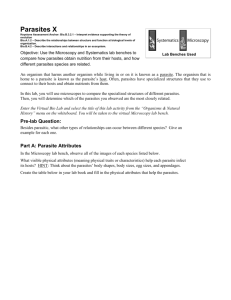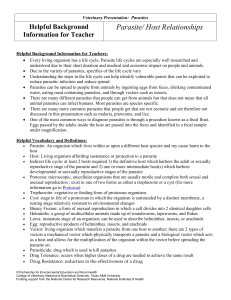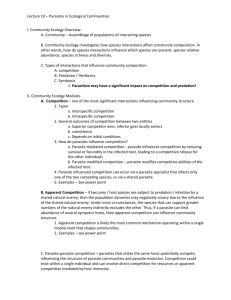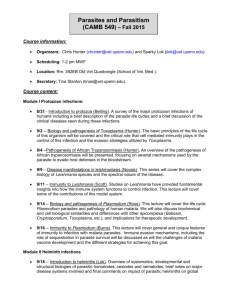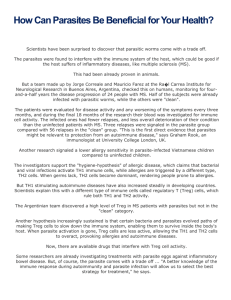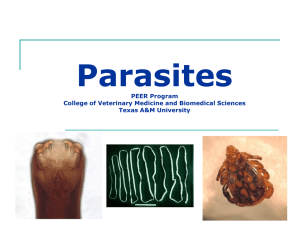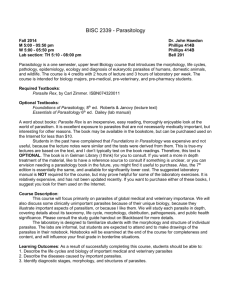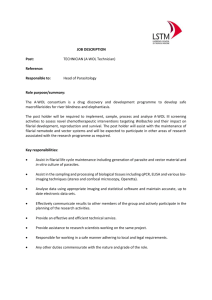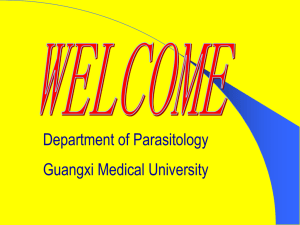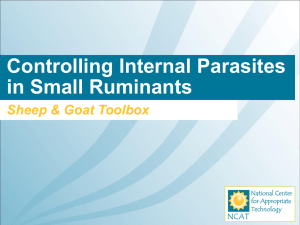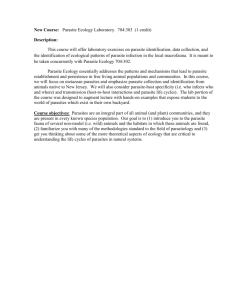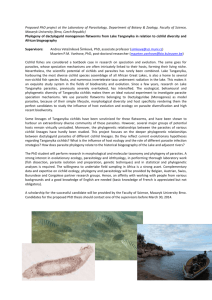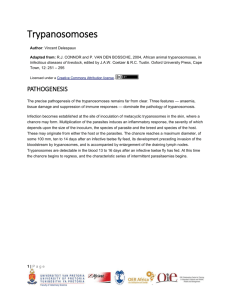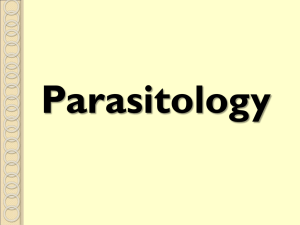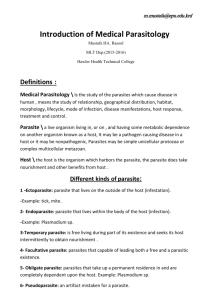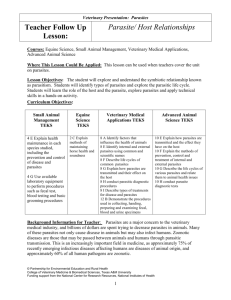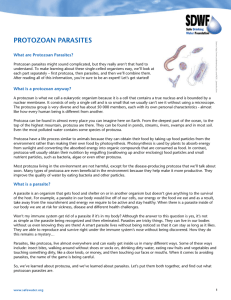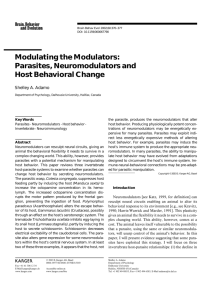Mention Ecologie, Biodiversité et Evolution
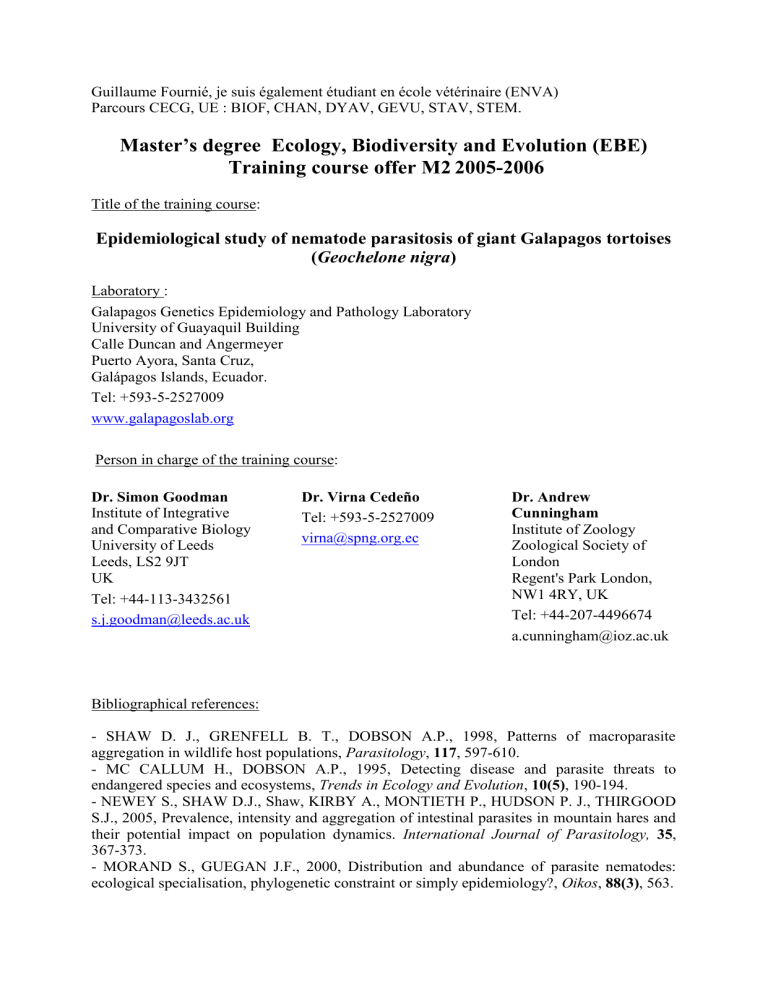
Guillaume Fournié, je suis également étudiant en école vétérinaire (ENVA)
Parcours CECG, UE : BIOF, CHAN, DYAV, GEVU, STAV, STEM.
Master’s degree Ecology, Biodiversity and Evolution (EBE)
Training course offer M2 2005-2006
Title of the training course:
Epidemiological study of nematode parasitosis of giant Galapagos tortoises
( Geochelone nigra )
Laboratory :
Galapagos Genetics Epidemiology and Pathology Laboratory
University of Guayaquil Building
Calle Duncan and Angermeyer
Puerto Ayora, Santa Cruz,
Galápagos Islands, Ecuador.
Tel: +593-5-2527009 www.galapagoslab.org
Person in charge of the training course:
Dr. Simon Goodman
Institute of Integrative and Comparative Biology
University of Leeds
Leeds, LS2 9JT
UK
Dr. Virna Cedeño
Tel: +593-5-2527009 virna@spng.org.ec
Dr. Andrew
Cunningham
Institute of Zoology
Zoological Society of
London
Regent's Park London,
NW1 4RY, UK
Tel: +44-207-4496674
Tel: +44-113-3432561 s.j.goodman@leeds.ac.uk
a.cunningham@ioz.ac.uk
Bibliographical references:
- SHAW D. J., GRENFELL B. T., DOBSON A.P., 1998, Patterns of macroparasite aggregation in wildlife host populations, Parasitology , 117 , 597-610.
- MC CALLUM H., DOBSON A.P., 1995, Detecting disease and parasite threats to endangered species and ecosystems, Trends in Ecology and Evolution , 10(5) , 190-194.
- NEWEY S., SHAW D.J., Shaw, KIRBY A., MONTIETH P., HUDSON P. J., THIRGOOD
S.J., 2005, Prevalence, intensity and aggregation of intestinal parasites in mountain hares and their potential impact on population dynamics. International Journal of Parasitology, 35 ,
367-373.
- MORAND S., GUEGAN J.F., 2000, Distribution and abundance of parasite nematodes: ecological specialisation, phylogenetic constraint or simply epidemiology?, Oikos , 88(3) , 563.
Context and aim of the training course:
Parasites can play an important role in driving the dynamics of their host populations
, these host-parasite interactions can be stable or lead to a cyclic or chaotic dynamics and, sometimes, pathogens can represent a serious threat to endangered species, occasionally causing sudden and unexpected local declines in abundance, in particular when they have been introduced by anthropogenic action in a naïve host population . They have been implicated in the extinction of some species. In contrast, endemic pathogens and parasites may operate as keystone species, playing a crucial role maintaining the diversity of ecological communities and ecosystems.
In 1999, there was an unusual mortality among the giant tortoises ( Geochelone nigra ) of Santa Cruz island in the Galapagos archipelago. Investigations at the time suggested different factors might have been responsible of this event. One of them was the presence of high quantities of nematode worms in the intestines of the dead individuals. Although they were tentatively identified as oxyurids, these parasites have not been formally identified to the species level and are likely to be an undescribed species.
A pulse of mortality in a population, coupled with high mean parasite burden, is often used to infer that a disease is affecting a population. Such a pattern may, however, be quite misleading. Given that the equilibrium prevalence of begnin infections is high, one may simply be observing a relatively harmless infection with the deaths occuring for a quite separate reason.
In the present case, basic informations such as species identification, quantification of the number of species, their distribution and abundance are unknown. Consequently, The
Galapagos Genetics Epidemiology and Pathology Laboratory (GGEPL) is leading an epidemiological study, begun in 2005. Part of the work in this study is to determine the abundance and the distribution of parasites and their impact on the host populations.
The first investigation have shown that these parasites are nematodes and that there is a great variability of parasite burden per host within host population. Indeed, macroparasites are almost invariably aggregated within their host population, with the majority of the parasite population concentrated into a minority of the host population, the variance of observed burdens is then very raised. In addition, parasite distribution frequencies fluctuate generally among the different populations and, at smaller scale, within the population, among different subclasses.
Therefore the aim of this study is to assess variations in parasite burdens associated with heterogeneities in the host population, in the parasite population and in extrinsic factors, in order to identify the factors responsible of this variability, and to quantify their importance.
The dependant variable used in this analysis is the number of eggs per gram of faecal sample per tortoise, used as estimation of parasite burden per host.
The aims of the study are to:
determine the diversity of these parasites (the differentiation of these parasites will be based on morphological differences of the eggs) and the spatial abundance distribution of the different parasite types across the archipelago.
identify the factors responsible of distribution frequency differences, and to generate a statistical model including these different factors. The predictor variables, which will be test for inclusion in the model, include host data (sex and age) and environnemental data (habitat – origin island, and status of the population, wild or captive).
In consequence, it would be possible to quantify the importance of this parasitosis within the tortoise population. This study will constitute a base for the assessment of the function of these parasites and their impact on the tortoise populations, in particular if other pulses of mortality occur again.
The progress of the training course:
-
-
During this training course, the work of the student will be composed by:
field work, collection of faecal samples from wild and captive tortoises. in laboratory, identication and counting of eggs. data analysis and statistical modelling.
In addition, in order to complete the parasite identification, it will be possible to conduct a preliminary genetic analysis by generating sequence data for ribosomal ITS markers
from larvae and adult nematodes recovered from faecal samples sampled from different locations.
These sequences will resolve relationships among the Galapagos tortoise nematodes by making use of phylogenetic information already known for other nematode species. This data would be considered preliminary since, due to the relatively short duration of the trainning course there would be probably not be time for a second round of sampling and sequencing in reponse to the initial data.
Bibliographical references of the surrounding team:
- Kilpatrick AM, Daszak P , Goodman SJ , Rogg H, Kramer LD, Cedeño V and Cunnungham
AA, West Nile virus Threatens Galãpagos through Tourism, Conservation Biology (In Press).
- Whiteman NK, SJ Goodman , BJ Sinclair, T Walsh, AA Cunningham , LD Kramer, and PG
Parker (2005). Establishment of the avian disease vector Culex quinquefasciatus Say 1823
(Diptera: Culicidae) on the Galápagos Islands, Ecuador, IBIS .
- Thiel T, NK Whiteman, A Tirape, MI Baquero, V Cedeño , T Walsh, G Jimenez-Uzcategui, and PG Parker (2005). Characterization of canarypox-like viruses infecting Endemic birds in the Galapagos islands. Journal Of Wildlife Diseases , 41(2) , 2005, 342–353.
- Harding KC, BJ Hansén and SJ Goodman (2005). Acquired immunity and stochasticity in epidemic intervals impede the evolution of host disease resistance, American Naturalist , 166 ,
722-730.
- Cunningham A.A
, Kirkwood J.K., Dawson M., Spencer Y.J., Green R.B., Wells G.A.H.
(2004), Bovine spongiform encephalopathy infectivity in greater kudu (Tragelaphus strepsiceros), Emerging Infectious Disease , 10 , 1044-1049.
- Goodman S.J.
, H.B. Tamate, R. Wilson, J. Nagata, S. Tatsuzawa, G.M. Swanson, J.M.
Pemberton, and D.R. McCullough (2001) Bottlenecks, drift and differentiation: the population structure and demographic history of sika deer ( Cervus nippon ) in the Japanese archipelago.
Molecular Ecology, 10 , 1357-1370.
- Daszak, P., Cunningham, A.A.
& Hyatt, A.D. (2000) Emerging Infectious Diseases of
Wildlife: Global Threats to Biodiversity and Human Health. Science, 287 , 443-449.
- Goodman, S. J.
, N. H. Barton, G. Swanson, K. Abernethy and J. M. Pemberton (1999)
Introgression through rare hybridisation: a genetic study of a hybrid zone between red and sika deer (genus Cervus ) in Argyll, Scotland. Genetics 152 , 355-371.
- Berger, L., Speare, R., Daszak, P., Greene, D.E., Cunningham, A.A.
, Goggin, C.L.,
Slocombe, R., Ragan, M.A., Hyatt, A.D., McDonald, K.R., Hines, H.B., Lips, K.R.,
Marantelli, G. & Parkes, H. (1998) Chytridiomycosis causes amphibian mortality associated
with population declines in the rain forests of Australia and Central America. Proceedings of the National Academy of Sciences of the United States of America , 95 , 9031-9036.

